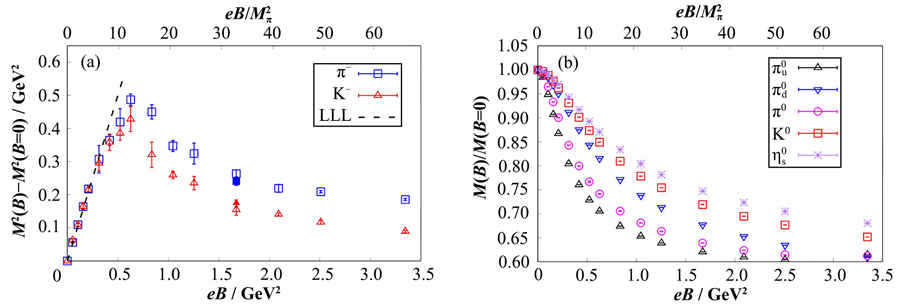Hengtong DING, Shengtai LI, Junhong LIU. Progress on QCD properties in strong magnetic fields from lattice QCD[J]. NUCLEAR TECHNIQUES, 2023, 46(4): 040008
Search by keywords or author
- NUCLEAR TECHNIQUES
- Vol. 46, Issue 4, 040008 (2023)
![Mass squared difference between the case at nonzero magnetic fields and eB=0 (a), ratio of pseudoscalar meson mass to their values at vanishing magnetic fields (b) as a function of eB[21]. The results are obtained based on lattice simulations of (2+1)-flavor QCD on 323×96 and 403×96 lattices using the highly improved staggered fermions with pion mass of 220 MeV.](/richHtml/hjs/2023/46/4/040008/040008-F001.jpg)
Fig. 1. Mass squared difference between the case at nonzero magnetic fields and eB=0 (a), ratio of pseudoscalar meson mass to their values at vanishing magnetic fields (b) as a function of eB[21]. The results are obtained based on lattice simulations of (2+1)-flavor QCD on 323×96 and 403×96 lattices using the highly improved staggered fermions with pion mass of 220 MeV.
![Continuum extrapolated results of the mass of ρ with a positive charge and spin sz=1, sz=-1 and neutralρ normalized to their corresponding values at vanishing magnetic fields as a function of eB[24]. The results are obtained based on the quenched lattice simulations with a valence pion mass 415 MeV.](/richHtml/hjs/2023/46/4/040008/040008-F002.jpg)
Fig. 2. Continuum extrapolated results of the mass of
Fig. 3. Decay constants of neutral pseudoscalar mesons (a), the square of decay constants obtained from the up and down quark component of the neutral pion (b) as a function of eB[21]. The solid line is the theoretical prediction from Ref.[31] and the lattice data is the same as used in the left plot.
Fig. 4. eB dependences of chiral condensate at eB < 0.9 GeV2 (a) and with eB up to 3.5 GeV2 (b)[21]
Fig. 5. Correction to two-flavor (a) and three-flavor (b) GMOR relation in nonzero magnetic fields[21]
Fig. 6. Pseudo-critical transition temperature as a function of eB (a), up quark chiral condensate as a function of Nb (b)[19]
Fig. 7. Difference of chiral condensate at eB=0.6 GeV2 and eB=0 as a function of pion mass along the corresponding trajectory of the pseudocritical temperature[34]. The inverse magnetic catalysis (IMC) is observed because the difference is negative while the magnetic catalysis is observed because the difference is positive. Similar results can be obtained from Ref.[35].
Fig. 8. Chiral and continuum extrapolation of the chiral phase transition temperaturem (a)[36]. The pseudocritical temperature at nonzero quark mass decreases with a lighter quark or pion. Similar results can be obtained in Ref.[37-38]. The contribution of a pion and kaon to the energy density of the thermal system in the framework of the hadron resonance gas model (b)[39]
Fig. 9. Numerical demonstration of the Ward-Takahashi identity at T=140 MeV and 281 MeV at nonzero magnetic fields[33] based on lattice QCD simulations with a pion and kaon masses of 220 MeV and 507 MeV, respectively. The demonstration at zero temperature can be obtained in Fig.5 in Ref.[21].
Fig. 10. Ratio of screening masses at nonzero magnetic fields to the corresponding values at zero magnetic fields as a function of eB at various temperatures for neutral pions (a) and kaons (b)[33]
Fig. 11. Ratio of valence (a) and sea (b) screening masses at nonzero magnetic fields to the corresponding values at zero magnetic fields as a function of eB at various temperatures for neutral pions[33]
Fig. 12. Demonstration of iso-spin symmetry breaking at nonzero magnetic fields[52]The grey dashed line denotes the results in the free limit, while the lattice QCD resutls are obtained with pion mass of 220 MeV.
Fig. 13. 2nd order baryon number fluctuation as a function of temperature at various magnetic fluxes (a)[52], a fit to the peak of the 2nd order baryon number fluctuation according to its critical behavior which results in
Fig. 14. Sketch plot of QCD phase diagram in the T-eB plane based on recent lattice results[22]. The red '+' at eB=4 GeV2 labels a crossover transition while it labels a first order phase transition at eB=9 GeV2.

Set citation alerts for the article
Please enter your email address



